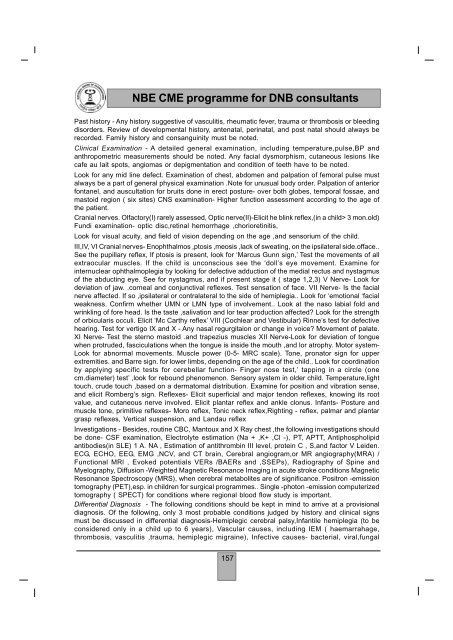NBE CME programme for DNB consultants - National Board Of ...
NBE CME programme for DNB consultants - National Board Of ...
NBE CME programme for DNB consultants - National Board Of ...
You also want an ePaper? Increase the reach of your titles
YUMPU automatically turns print PDFs into web optimized ePapers that Google loves.
<strong>NBE</strong> <strong>CME</strong> <strong>programme</strong> <strong>for</strong> <strong>DNB</strong> <strong>consultants</strong>Past history - Any history suggestive of vasculitis, rheumatic fever, trauma or thrombosis or bleedingdisorders. Review of developmental history, antenatal, perinatal, and post natal should always berecorded. Family history and consanguinity must be noted.Clinical Examination - A detailed general examination, including temperature,pulse,BP andanthropometric measurements should be noted. Any facial dysmorphism, cutaneous lesions likecafe au lait spots, angiomas or depigmentation and condition of teeth have to be noted.Look <strong>for</strong> any mid line defect. Examination of chest, abdomen and palpation of femoral pulse mustalways be a part of general physical examination .Note <strong>for</strong> unusual body order. Palpation of anteriorfontanel, and auscultation <strong>for</strong> bruits done in erect posture- over both globes, temporal fossae, andmastoid region ( six sites) CNS examination- Higher function assessment according to the age ofthe patient.Cranial nerves. Olfactory(I) rarely assessed, Optic nerve(II)-Elicit he blink reflex,(in a child> 3 mon.old)Fundi examination- optic disc,retinal hemorrhage ,chorioretinitis,Look <strong>for</strong> visual acuity, and field of vision depending on the age ,and sensorium of the child.III,IV, VI Cranial nerves- Enophthalmos ,ptosis ,meosis ,lack of sweating, on the ipsilateral side.offace..See the pupillary reflex, If ptosis is present, look <strong>for</strong> ‘Marcus Gunn sign,’ Test the movements of allextraocular muscles. If the child is unconscious see the ‘doll’s eye movement. Examine <strong>for</strong>internuclear ophthalmoplegia by looking <strong>for</strong> defective adduction of the medial rectus and nystagmusof the abducting eye. See <strong>for</strong> nystagmus, and if present stage it ( stage 1,2,3) V Nerve- Look <strong>for</strong>deviation of jaw. .corneal and conjunctival reflexes. Test sensation of face. VII Nerve- Is the facialnerve affected. If so ,ipsilateral or contralateral to the side of hemiplegia.. Look <strong>for</strong> ‘emotional ‘facialweakness. Confirm whether UMN or LMN type of involvement.. Look at the naso labial fold andwrinkling of <strong>for</strong>e head. Is the taste ,salivation and lor tear production affected? Look <strong>for</strong> the strengthof orbicularis occuli. Elicit ‘Mc Carthy reflex’ VIII (Cochlear and Vestibular) Rinne’s test <strong>for</strong> defectivehearing. Test <strong>for</strong> vertigo IX and X - Any nasal regurgitaion or change in voice? Movement of palate.XI Nerve- Test the sterno mastoid .and trapezius muscles XII Nerve-Look <strong>for</strong> deviation of tonguewhen protruded, fasciculations when the tongue is inside the mouth ,and lor atrophy. Motor system-Look <strong>for</strong> abnormal movements. Muscle power (0-5- MRC scale). Tone, pronator sign <strong>for</strong> upperextremities. and Barre sign. <strong>for</strong> lower limbs, depending on the age of the child.. Look <strong>for</strong> coordinationby applying specific tests <strong>for</strong> cerebellar function- Finger nose test,’ tapping in a circle (onecm.diameter) test’ ,look <strong>for</strong> rebound phenomenon. Sensory system in older child. Temperature,lighttouch, crude touch ,based on a dermatomal distribution. Examine <strong>for</strong> position and vibration sense,and elicit Romberg’s sign. Reflexes- Elicit superficial and major tendon reflexes, knowing its rootvalue, and cutaneous nerve involved. Elicit plantar reflex and ankle clonus. Infants- Posture andmuscle tone, primitive reflexes- Moro reflex, Tonic neck reflex,Righting - reflex, palmar and plantargrasp reflexes, Vertical suspension, and Landau reflexInvestigations - Besides, routine CBC, Mantoux and X Ray chest ,the following investigations shouldbe done- CSF examination, Electrolyte estimation (Na + ,K+ ,Cl -), PT, APTT, Antiphospholipidantibodies(in SLE) 1 A. NA , Estimation of antithrombin III level, protein C , S,and factor V Leiden.ECG, ECHO, EEG, EMG ,NCV, and CT brain, Cerebral angiogram,or MR angiography(MRA) /Functional MRl , Evoked potentials VERs /BAERs and ,SSEPs), Radiography of Spine andMyelography, Diffusion -Weighted Magnetic Resonance Imaging in acute stroke conditions MagneticResonance Spectroscopy (MRS), when cerebral metabolites are of significance. Positron -emissiontomography (PET),esp. in children <strong>for</strong> surgical <strong>programme</strong>s.. Single -photon -emission computerizedtomography ( SPECT) <strong>for</strong> conditions where regional blood flow study is important.Differential Diagnosis - The following conditions should be kept in mind to arrive at a provisionaldiagnosis. <strong>Of</strong> the following, only 3 most probable conditions judged by history and clinical signsmust be discussed in differential diagnosis-Hemiplegic cerebral palsy,Infantile hemiplegia (to beconsidered only in a child up to 6 years), Vascular causes, including IEM ( haemarrahage,thrombosis, vasculitis ,trauma, hemiplegic migraine), Infective causes- bacterial, viral,fungal157
















